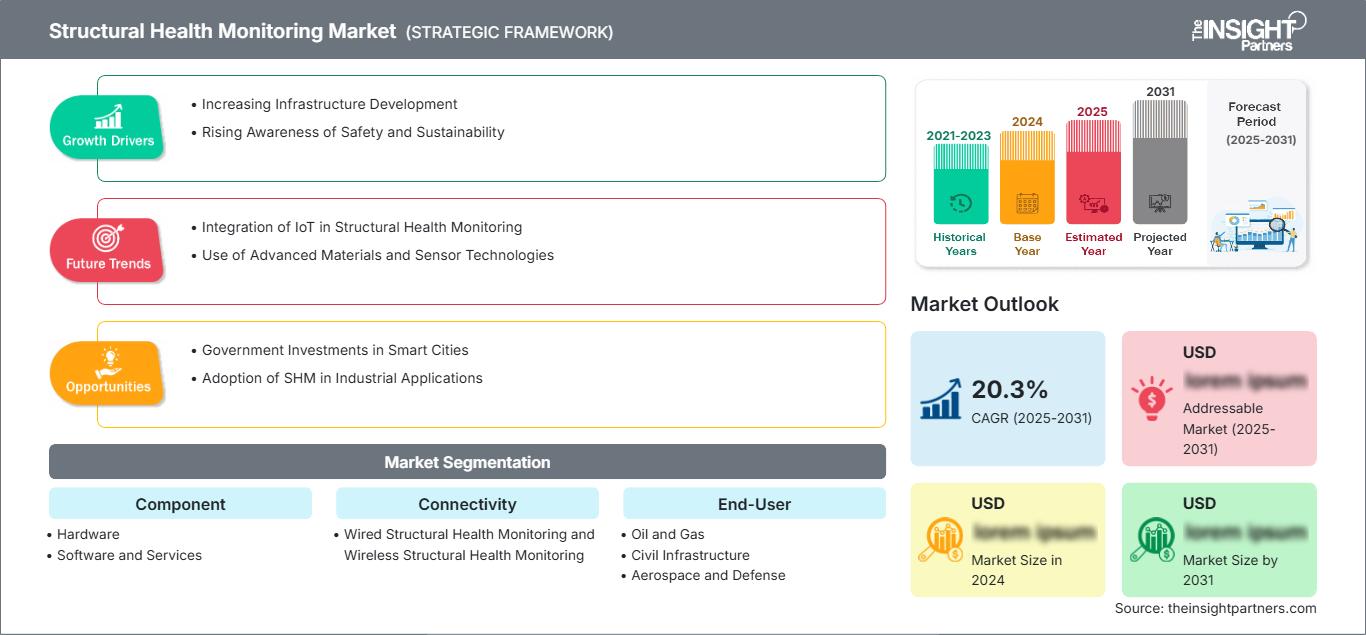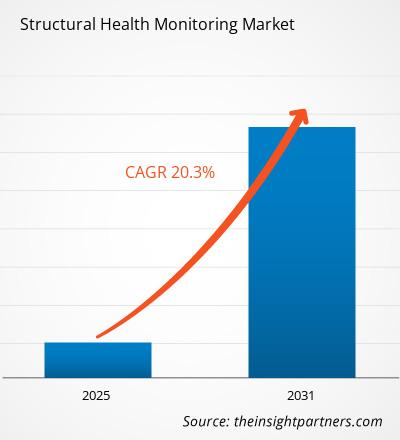Der Markt für Strukturüberwachung wird voraussichtlich zwischen 2025 und 2031 eine durchschnittliche jährliche Wachstumsrate (CAGR) von 20,3 % verzeichnen, wobei die Marktgröße von XX Millionen US-Dollar im Jahr 2024 auf XX Millionen US-Dollar im Jahr 2031 anwachsen wird.
Der Bericht ist nach Komponenten (Hardware, Software und Dienste), Konnektivität (kabelgebundene und kabellose Strukturüberwachung) und Endnutzern (Öl und Gas, zivile Infrastruktur, Luft- und Raumfahrt und Verteidigung, Energie, Bergbau und andere) segmentiert. Die globale Analyse ist weiter nach regionalen und wichtigen Ländern aufgeschlüsselt. Der Bericht bietet den Wert in USD für die oben genannte Analyse und Segmente.
Zweck des Berichts
Der Bericht „Markt für Strukturüberwachung“ von The Insight Partners zielt darauf ab, die aktuelle Situation und das zukünftige Wachstum sowie die wichtigsten treibenden Faktoren, Herausforderungen und Chancen zu beschreiben. Dadurch erhalten verschiedene Geschäftsinteressenten Einblicke, beispielsweise:
- Technologieanbieter/-hersteller: Um die sich entwickelnde Marktdynamik zu verstehen und die potenziellen Wachstumschancen zu kennen, sodass sie fundierte strategische Entscheidungen treffen können.
- Investoren: Um eine umfassende Trendanalyse hinsichtlich der Marktwachstumsrate, der finanziellen Marktprognosen und der Chancen entlang der Wertschöpfungskette durchzuführen.
- Regulierungsbehörden: Um Richtlinien und Überwachungsaktivitäten auf dem Markt zu regulieren, mit dem Ziel, Missbrauch zu minimieren, das Vertrauen der Investoren zu wahren und die Integrität und Stabilität des Marktes aufrechtzuerhalten.
Marktsegmentierungskomponente für Strukturzustandsüberwachung
- Hardware
- Software und Dienste
Konnektivität
- Kabelgebundene und drahtlose Strukturzustandsüberwachung
Endbenutzer
- Öl und Gas
- Zivile Infrastruktur
- Luft- und Raumfahrt und Verteidigung
- Energie
- Bergbau
- Sonstige
Geografie
- Nordamerika
- Europa
- Asien-Pazifik
- Süd- und Mittelamerika
- Naher Osten und Afrika
Sie erhalten kostenlos Anpassungen an jedem Bericht, einschließlich Teilen dieses Berichts oder einer Analyse auf Länderebene, eines Excel-Datenpakets sowie tolle Angebote und Rabatte für Start-ups und Universitäten.
Markt für strukturelle Gesundheitsüberwachung: Strategische Einblicke

-
Holen Sie sich die wichtigsten Markttrends aus diesem Bericht.Dieses KOSTENLOSE Beispiel umfasst Datenanalysen, die von Markttrends bis hin zu Schätzungen und Prognosen reichen.
Wachstumstreiber für den Markt für Strukturüberwachung
- Zunehmende Infrastrukturentwicklung: Das anhaltende Wachstum von Infrastrukturprojekten weltweit, wie Brücken, Gebäuden und Autobahnen, treibt die Nachfrage nach Systemen zur Strukturüberwachung (SHM) an. Diese Systeme tragen dazu bei, die Sicherheit, Haltbarkeit und Langlebigkeit dieser Strukturen zu gewährleisten, Wartungskosten zu minimieren und Ausfälle zu vermeiden.
- Steigendes Bewusstsein für Sicherheit und Nachhaltigkeit: Das wachsende Bewusstsein für die Bedeutung von Sicherheit, ökologischer Nachhaltigkeit und Anlagenverwaltung fördert die Einführung von SHM-Systemen. Diese Technologien helfen, strukturelle Probleme frühzeitig zu erkennen, rechtzeitige Reparaturen zu gewährleisten und die Umweltauswirkungen von Infrastrukturschäden zu reduzieren.
Zukünftige Trends im Markt für Strukturüberwachung
- Integration des IoT in die Strukturüberwachung: Die Integration von Technologien des Internets der Dinge (IoT) revolutioniert die SHM. IoT-fähige Sensoren liefern Echtzeitdaten über den Zustand von Strukturen und verbessern so die Effizienz und Genauigkeit der Überwachung. Dieser Trend führt zu stärker automatisierten, kostengünstigeren und skalierbaren SHM-Lösungen in verschiedenen Branchen.
- Einsatz fortschrittlicher Materialien und Sensortechnologien: Fortschritte bei Sensortechnologien und Materialien, wie z. B. Glasfasersensoren und Kohlenstoffnanoröhren, verbessern die Leistungsfähigkeit von SHM-Systemen. Diese Innovationen ermöglichen eine genauere, zuverlässigere und langlebigere Überwachung der strukturellen Integrität und erweitern die SHM-Anwendungen in kritischer Infrastruktur wie Staudämmen, Hochhäusern und Offshore-Plattformen.
Marktchancen für Strukturüberwachung
- Staatliche Investitionen in Smart Cities: Der Vorstoß für Smart-City-Initiativen bietet erhebliche Chancen für SHM-Lösungen. Regierungen investieren in intelligente Infrastruktur mit integrierten Überwachungssystemen, um die Widerstandsfähigkeit der Städte zu verbessern, was zu einer erhöhten Nachfrage nach fortschrittlichen SHM-Technologien in Städten weltweit führt.
- Einführung von SHM in industriellen Anwendungen: Branchen wie Öl und Gas, Luft- und Raumfahrt sowie Energie setzen SHM-Systeme ein, um die Integrität kritischer Anlagen zu überwachen. Da die Industrie versucht, Ausfallzeiten und Wartungskosten zu reduzieren, wird die Nachfrage nach SHM-Lösungen in industriellen Anwendungen voraussichtlich erheblich steigen.
Markt für Strukturüberwachung
Die Analysten von The Insight Partners haben die regionalen Trends und Faktoren, die den Markt für Strukturüberwachung im Prognosezeitraum beeinflussen, ausführlich erläutert. In diesem Abschnitt werden auch die Marktsegmente und die geografische Lage in Nordamerika, Europa, im asiatisch-pazifischen Raum, im Nahen Osten und Afrika sowie in Süd- und Mittelamerika erörtert.Umfang des Marktberichts zur strukturellen Zustandsüberwachung
Dichte der Marktteilnehmer im Bereich Strukturelle Gesundheitsüberwachung: Verständnis ihrer Auswirkungen auf die Geschäftsdynamik
Der Markt für Strukturüberwachung wächst rasant. Dies wird durch die steigende Endverbrauchernachfrage aufgrund veränderter Verbraucherpräferenzen, technologischer Fortschritte und eines stärkeren Bewusstseins für die Produktvorteile vorangetrieben. Mit der steigenden Nachfrage erweitern Unternehmen ihr Angebot, entwickeln Innovationen, um den Verbraucherbedürfnissen gerecht zu werden, und nutzen neue Trends, was das Marktwachstum weiter ankurbelt.
- Holen Sie sich die Markt für strukturelle Gesundheitsüberwachung Übersicht der wichtigsten Akteure
Wichtige Verkaufsargumente
- Umfassende Abdeckung: Der Bericht analysiert umfassend Produkte, Dienstleistungen, Typen und Endnutzer des Marktes für Strukturüberwachung und bietet einen ganzheitlichen Überblick.
- Expertenanalyse: Der Bericht basiert auf dem umfassenden Verständnis von Branchenexperten und Analysten.
- Aktuelle Informationen: Der Bericht gewährleistet Geschäftsrelevanz durch die Berichterstattung über aktuelle Informationen und Datentrends.
- Anpassungsoptionen: Dieser Bericht kann an spezifische Kundenanforderungen angepasst werden und passt sich optimal an die Geschäftsstrategien an.
Der Forschungsbericht zum Markt für Strukturüberwachung kann daher dazu beitragen, die Branchensituation und die Wachstumsaussichten zu entschlüsseln und zu verstehen. Obwohl es einige berechtigte Bedenken geben mag, überwiegen die Vorteile dieses Berichts tendenziell die Nachteile.
- Historische Analyse (2 Jahre), Basisjahr, Prognose (7 Jahre) mit CAGR
- PEST- und SWOT-Analyse
- Marktgröße Wert/Volumen – Global, Regional, Land
- Branchen- und Wettbewerbslandschaft
- Excel-Datensatz
Aktuelle Berichte
Erfahrungsberichte
Grund zum Kauf
- Fundierte Entscheidungsfindung
- Marktdynamik verstehen
- Wettbewerbsanalyse
- Kundeneinblicke
- Marktprognosen
- Risikominimierung
- Strategische Planung
- Investitionsbegründung
- Identifizierung neuer Märkte
- Verbesserung von Marketingstrategien
- Steigerung der Betriebseffizienz
- Anpassung an regulatorische Trends






















 Kostenlose Probe anfordern für - Markt für strukturelle Gesundheitsüberwachung
Kostenlose Probe anfordern für - Markt für strukturelle Gesundheitsüberwachung